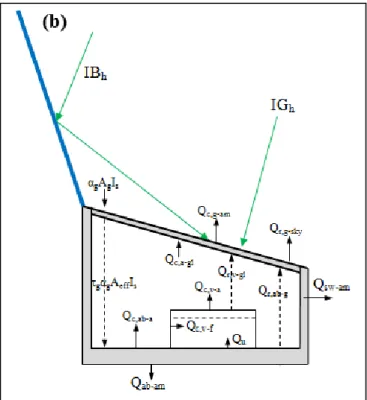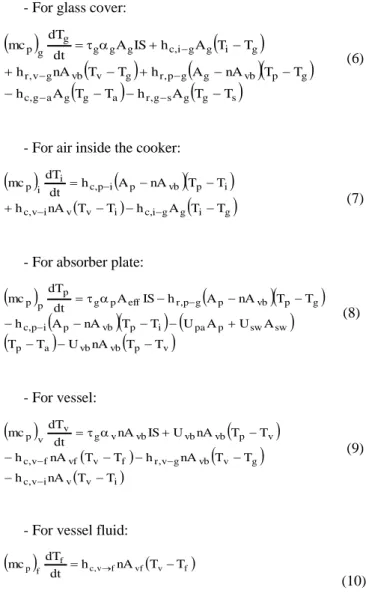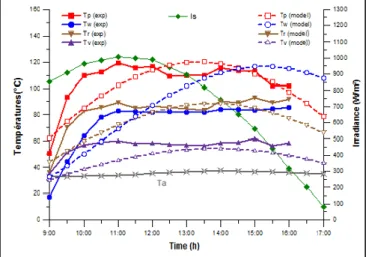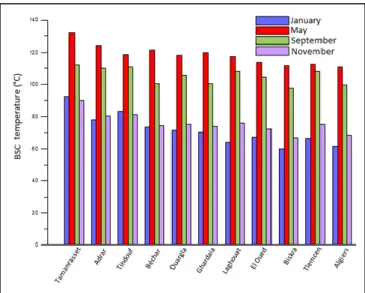ISMRE2018/XXXX-2018 ALGERIA
Mathematical Model and experimental testing of a
plane mirror augmented box solar cooker with
trapezium shape
F. Yettou
1, A. Gama
1, N. Rathore
2, R. Khelifi
11Unité de Recherche Appliquée en Energies Renouvelables, URAER, Centre de Développement des Energies Renouvelables,
CDER, 47133, Ghardaïa, Algeria
2 Department of Renewable Energy Engineering, Maharana Pratap University of Agriculture and Technology, Udaipur,
Rajasthan 313001, India ………
yettou.t@gmail.com
Abstract—Solar cooking technology is one of the attractive
options in developing countries capable to meet energy-cooking demand. In this paper, a mathematical model of the heat transfer mechanisms involved with a plane mirror augmented box-type solar energy cooker has been presented in order to determine the thermal behaviour in the cooker based on the energy balance equations for the temperature elements. The cooker is constructed with a trapezium shape for maximising solar beam falling onto the absorber plate and equipped with a plane booster mirror reflector hinged at the top of the cooker for maximum concentration. The model is based on an analytical solution of the energy balance equations for different components of the cooker: such as glass cover, air inside, absorber plate, cooking vessel, cooking fluid. To validate the model, the temperature distribution obtained by a developed computer program is compared with experimental results measured for a typical day in Ghardaïa (32.39 °N, 3.78 °E) Algeria). For this purpose, the box solar cooker were designed, realized and tesyed by the authors at URAER? Ghardaïa. A data acquisition chain equipped with various measuring instruments was installed for the control of the system. The values of measured cooker’s temperatures through the AGILENT data acquisition unit were visualized numerically and graphically. The theoretical results are found to be in good agreement with the experimental results. The model was then employed to simulate the performance of the realized solar cooker, several temperature maps were obtained for summer and winter clear sky conditions at Algeria country showing areas in which the solar cooker can be operated effectively during the year. The sample results presented in this paper indicated the high potential of solar cooking in the study region depending on the amount of received solar radiation.
Keywords—Global solar radiation, Box solar cooker, Thermal modeling, Experimental validation, Temperature mapping.
NOMENCLATURE
s Solar altitude angle [rad]
IN
IBh, IDh, IGh,
Direct normal
irradiance;
Beam, diffuse and global irradiance on horizontal surface [W/m²] Ta, Ts Ambient, sky temperature [°C]
Tg, Ti, Tp, Tv, Tf Glass cover, air inside, absorber plate, cooking vessel, cooking fluid temperature related to BSC [°C] Qc, Qr Convective and
radiation heat flux
[W] Q, U Thermal losses [W] hc, hr Convective and radiation heat coefficient [W/ m²K] mcp heat capacity [J/K] ρ Water density=1000 [kg/m3] Ag, Aeff, Avb, Ap, Av, Avf, Asw, Aref, Aspot, Apot, Apf
Area [m²] g
,
p,
v,
ref, pot
Absorptivity [-] g
,ρB Transmissivity and reflectivity [-] Ws Wind speed [m/s] I. INTRODUCTIONActually, fossil fuels based energy consumption progresses by an average of 1% in developed countries and 5% in developing countries [1, 2]. However, limited fossil resources and environmental problems imply that development of solar energy appliances will play major role in incoming years, especially to meeting domestic energy requirements. Solar cooking technology may be one of the attractive options in developing countries capable to meet energy-cooking demand with minimizing the CO2 emission all over the world. As underlined by Panwar et al. [3], that over the period from 1971 to 1995, CO2 emissions grew at an average rate of 1.7% per year [4]. By 2020, the developing countries could account for half of global CO2 emissions. Different types of cookers like box-type and concentrating type can be found in literature with several classifications, the most recent one was proposed by Yettou et al. in their review [1]. Thermal modelling is one of the most significant aspect, which has a great importance in predicting thermal performance of solar cookers; many works have been reported in literature about this subject last years [5-11]. Nevertheless, hardly any study is to be found about
mathematical modeling of box-type solar cooker with external reflectors (plane mirror) [12]. In this paper, a mathematical model of the heat transfer mechanisms involved with a plane mirror augmented box-type solar cooker will be presented. The model is based on an analytical solution of the energy balance equations for different components of the cooker solved by a developed computer program. The model, once validated; is applied to estimate the cooking energy potential in Algeria using the realized BSC.
II. ANALYSIS
A. Design description of the solar cooker
A photographic view of the realized solar cooker and the various heat transfer exchanges inside the cooker are illustrated in “Fig. 1”. The realized box solar cooker (BSC) consists of an outer wooden box, inner glazing cooking box, the simple glass lid, thermal insulator, mirrors, and cooking containers. The solar radiation falls onto the glass lid and passes through it to strike the absorber plate. The inside air, in contact with the absorber, warms up and transmits its heat to the cooking pot which transferred the heat to the inside food. The hot box cooker dimensions are 500 × 400 × 445 × 125 mm. The space between the outer box and inner tray, including the bottom of the tray, is packed with insulating material to reduce heat losses from the cooker. A glass lid covers the inner box. The absorber made of aluminium sheet painted matt black absorbs the solar radiation and transfers the heat to the cooking pots. The aluminium cooking pot (18 cm in diameter and 10 cm in height) is cylindrical in shape, filled with water, painted and equipped with a black cover, was placed into the solar box cooker. The box solar cooker is designed with trapezium shape to improve the interception of solar radiation, especially in winter months. A plan reflector (booster mirror) of 500 × 400 mm was placed on the top of the cooker so that the incoming solar radiation by the tilted aperture area is reflected towards the absorber-plate. To adjust this reflector at desired angles, hole is provided on the right side wall of the cooker.
Fig. 1. The BSC realized at URAER, Ghardaïa: (a) photograph view (b) Various mode of heat transfer in the BSC.
B. Mathematical model
The heat transfer model is obtained by replacing the heat transfer flux on the energy balance equations as follow:
- For glass cover:
g g s c,g o r,g sky g g p A I Q Q dt dT mc (1)- For air inside the cooker:
c,ab a c,v a c,a g a a p Q Q Q dt dT mc (2)- For absorber plate:
g ab eff s r,ab g c,ab a ab o sw o u ab ab p A I Q Q Q Q Q dt dT mc (3) - For vessel:
c,v f c,v f vf
v f
f f p Q h nA T T dt dT mc (4)- For vessel fluid:
pv v g vnAvbIs Qu Qc,v f Qr,v g Qc,v a dtdT
mc
(5) Developing these equations, we obtain:
- For glass cover:
g a
r,g s g
g s
g a g , c g p vb g g p , r g v vb g v , r g i g g i , c g g g g g p T T A h T T A h T T nA A h T T nA h T T A h IS A dt dT mc (6)- For air inside the cooker:
v i
c,i g g
i g
v i v , c i p vb p i p , c i i p T T A h T T nA h T T nA A h dt dT mc (7)- For absorber plate:
p a
vb vb
p v
sw sw p pa i p vb p i p , c g p vb p g p , r eff p g p p p T T nA U T T A U A U T T nA A h T T nA A h IS A dt dT mc (8) - For vessel:
v i
v i v , c g v vb g v , r f v vf f v , c v p vb vb vb v g v v p T T nA h T T nA h T T nA h T T nA U IS nA dt dT mc (9)- For vessel fluid:
pf f hc,v fnAvf
Tv Tf
dtdT
mc
(10)
“Equation (6) to (10)” form a coupled system of nonlinear differential equations. To solve them, we developed a computer program in MATLAB that uses the iterative process. The solution of these equations gives the instantaneous temperatures of the variables Tg , Ti, Tp , Tv , and Tf of the BSC.
C. Adopted methodology
In order to draw BSC temperature maps, several steps are necessary:
1- Linke turbidity database: retrieved for each month from the SoDa project website [13].
2- Solar radiation program: developed using Matlab programming language [14] to calculate solar irradiance.
3- Thermal model program: developed for a computer simulation to predict temperature values of Tg , Ti, Tp , Tv , and Tf of the BSC.
4- Thermal model validation: a series of experiments were conducted for several days and compared to predicted values.
5- The above previous steps (2 and 3) are applied to different points with different geographical locations of Algeria (Lat, Long, Alt) to create a compatible matrix format for Surfer Golden Software [15]. The Golden Software
Surfer Inc software is a universal tool path contours, surfaces and 3D cartographic representations. It also allows to interpolate between two adjacent points with high accuracy. Reading the matrix file XYZ by the Surfer software, offers the possibility to project the obtained results on illustrative and analysable maps. So, maps of different temperatures of the two cookers are obtained for different months of the year and the cookers efficiency (effectiveness) maps can be then deduced.
D. Experimental test equipment and measurements
The performance test of the BSC was conducted during several days in winter and summer season “Fig. 2”. The international test standard requirements were applied to the BSC tests for each day. During the experimental period, the following parameters were recorded: ambient temperature Ta, water temperatures in the pot Tf, air temperature inside the box Ti, glass cover temperature Tg, absorber plate temperature Tp, global solar radiation on a horizontal surface Is, and wind speed Ws. The solar radiation on a horizontal surface was measured by a Kipp & Zonen CMP21 pyranometer. The ambient temperature was measured using a Campbell CS215 Temperature. The wind speed was measured using NRG 40H Anemometer. The water temperature was measured using thermocouple which has been inserted through a hole in the lid of the cooker. Three thermocouples were located at different places in the cooker were used to measure the glass, absorber and inside air temperatures. A data-logger AGILENT 34972A [16] was used for taking the readings from the sensors. The data were registered by the data-logger in intervals of 5 minutes.
Fig. 2. Block diagram of BSC installation and data acquisition system.
III. RESULTS AND DISCUSSIONS
A. Weather Data
The cooker was tested as per the method outlined by Funk (2000) [17] who presented and evaluated the test standard of the solar cookers proposed at the Third World Conference on Solar Cooking. The tests were conducted when the wind speed was low. The solar cooker tests were conducted when the ambient temperature was between 20 and 35°C. Data was recorded for water temperatures between 40 and 90°C. The tests were conducted when the solar radiation is in the range of 450 and 1100W/m² during the
tests. “Fig. 3” show plots of instantaneous values of solar irradiance (in W/m²) and ambient air temperature at Ghardaîa for the six selected days of tests.
Fig. 3. Direct normal, global, diffuse irradiance and ambient air temperature for the six days of tests on May and June months at Ghardaîa.
B. Model validation
The “Fig. 4” is an example of validation of our results for a typical day of May month on the Ghardaïa site. The ambient temperature varies between 32.8 and 37.4 ° C, while the intensity of the solar radiation varies between 83 and 1005 W/m². The temperature of the absorber gradually increases with time until stagnation around noon. The experimental values vary around the theoretical values and represent an average of 106.14 °C with respect to the calculated values (108 °C). The water experimental temperature in the pot increases with the solar radiation to reach its maximum 82.5 °C at 11:30 h, while the predicted value is 78.4 °C, with a difference of 4.1 °C. We can conclude that our developed model is able to predict temperatures of BSC elements with values very close to the experimental data.
Fig. 4. Variation of experimental, predicted BSC temperatures and solar flux with time for a typical day of May month.
C. Statistical analysis
The root mean square error (RSME), standard error (SE), and coefficient of correlation (r) were calculated to assess the feasibility of the developed model. The values of the coefficient of correlation (r) for all months were higher than 0.9, indicating that the developed model is capable of
predicting the water temperature close to experimental values. The standard error varied from 2.55 to 5.4 whereas the root mean square error varied from 2.7 to 5.7 as presented in Table I.
TABLE I. STATISTICAL ANALYSIS OF PREDICTED
TEMPERATURE.
Months Statistical parameters
SE RSME r
Winter 5.40 5.77 0.989
Summer 2.552 2.795 0.982
Spring 3.849 4.115 0.964
D. Solar cooker temperature maps
After model validation, an other application of the thermal model is the evaluation of solar cooking potential of the solar cooker in local climatic conditions at Algeria based on solar radiation model and ambient temperatures. The temperature maps produced are able to predict the cookers effectiveness for different seasons under clear skies. “Fig. 5” represent the mapping of absorber plate temperatures of BSC obtained for a typical day of December and June month, respectively.
Fig. 5. Absorber plate temperature maps of the realized BSC’s for Algeria at: (a) December month; (b) June month.
Knowing the water temperature values of BSC for any site in Algeria from figure 5, we can now deduce the solar
cooker effectiveness mapping. On the graph of “Fig. 6”, a summary of absorber temperatures of BSC is illustrated for the main Algeria sites. Using this graph, we can deduce the effectiveness map of the cooker during all year months, which is represented in “Fig. 7”. From “Fig. 7”, we can determinate, with precision; the feasibility and rentability of using the cooker at any location and for any month of the year. For example, the use of the BSC at Ghardaïa city can be exploited during the period from February to November (10 months), the use duration of the cooker is reduced by going to North cities, we can use the realized cooker only for 9 months (from February to October) at Biskra city.
Fig. 6. Representation of absorber temperatures reached by BSC for some Algerian sites in clear days for different seasons.
Fig. 7. BSC effectiveness map for Algerian territory during all month of year.
IV. CONCLUSION
As the global demand for cooking energy is expected to increase greatly in coming years, solar cooking devices can play a major role to reduce or substitute energy consumption from fossils resources. In this paper, mathematical model of a plane mirror augmented box-type solar cooker has been presented based on the energy balance equations of
temperature elements of the cooker and solved by a developed computer program. . The temperature of different components of the solar cookers was measured during several months, and the experimental values were compared to that predicted by the thermal model. It is found that the experimental and predicted temperatures values agree well. As an application of the mathematical model is the mapping of BSC effectiveness for Algerian territory around the year. It is found that the use of the cooker is not identical from site to site depending on the amount of solar radiation. The use of the cooker is reduced for the littoral regions and more beneficial for Saharan sites.
ACKNOWLEDGMENT
Authors are very thankful to Renewables Energies Development Center (CDER, Algeria) and Applied Research Unit on Renewable Energies (URAER, Ghardaïa) for supporting and financing the solar cooking projects.
REFERENCES
[1] Yettou F, Azoui B, Malek A, Gama A, Panwar N.L. Solar cooker realizations in actual use: An overview. Renewable Sustainable Energy Rev 2014;37:288–306.
[2] Boudghene Stambouli A, Koinuma H. A primary study on a long-term vision and strategy for the realisation and the development of the Sahara Solar Breeder project in Algeria. Renewable Sustainable Energy Rev 2012;16:591–8.
[3] Panwar N.L, Kaushik S.C, Kothari S. Role of renewable energy sources in environmental protection: A review. Renewable Sustainable Energy Rev 2011;15:1513–24.
[4] IEA. World Energy Outlook. ed. Paris: IEA/OECD,1998.
[5] El-sebaii A.A. Thermal performance of a box-type solar cooker with outer-inner reflectors. Energy 1997; 22(10): 969–78.
[6] Amer E.H. Theoretical and experimental assessment of a double exposure solar cooker. Energy Convers. Manage 2003;44: 2651–63. [7] Punia R.C, Marwal V.K, Sengar N, Dashora P. Numerical Modeling
of a Box-Type Solar Cooker. Int J Thermal Sci 2012;4:75–83. [8] Ayub I, Munir A, Amjad W, Ghafoor A, Nasir MS. Energy-and
exergy-based thermal analyses of a solar bakery unit. J Thermal Anal Calorim. 2018;133(2):1001–13.
[9] Amer EH. Theoretical and experimental assessment of a double exposure solar cooker. Energy Convers Manag. 2003;44:2651–63. [10] Kurt H, Atik K, Ozkaymak M, Recebli Z. Thermal performance
parameters estimation of hot box type solar cooker by using artificial neural network. Int J Thermal Sci. 2008;47:192–200.
[11] Verdugo AS. Experimental analysis and simulation of the performance of a box-type solar cooker. Energy Sustain Dev. 2015;29:65–71.
[12] Verdugo A.S. Experimental analysis and simulation of the performance of a box-type solar cooker. Energy Sustain Dev 2015;29:65–71.
[13] Gschwind B, Mnard L, Albuisson M, Wald L, Three years of experience with the SoDa web service delivering solar radiation information: lessons learned and perspectives. In: Hrebicek, J., Racek, J. (Eds.), Proc. 19th Int. Conf. Inf. Environ. Prot., Part 1. Published by
the Masaryk University in Brno, Czech Republic, 2005, pp. 95-102. [14] Matlab/Simulink Tutorial, School of Electrical, Electronic and
Computer Engineering, Version 7.10, 1st Edition, 2010. [15] Surfer User’s guide, 3rd edition, Golden Software Inc., 1999. [16] ‘34972A LXI Data Acquisition’, keysight, 2000-2014. Available
online at: http://www.keysight.com/ja/pd-1756491-pn-34972A/lxi-data-acquisition-data-logger-switch-unit?&cc=DZ&lc=eng.
[17] Funk P.A., Evaluating the international standard procedures for testing solar cookers and reporting performance, Solar Energy, 68, 11, pp. 1-7 (2000).



